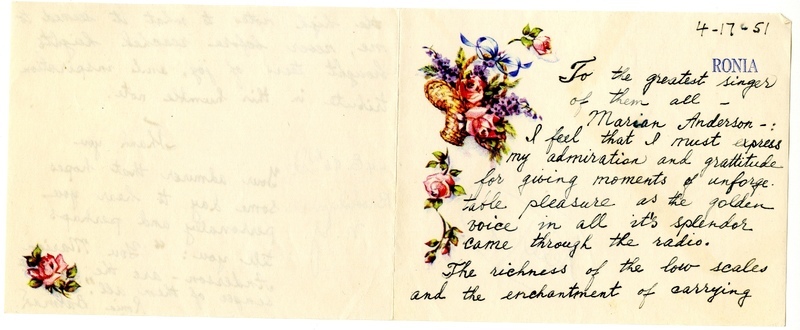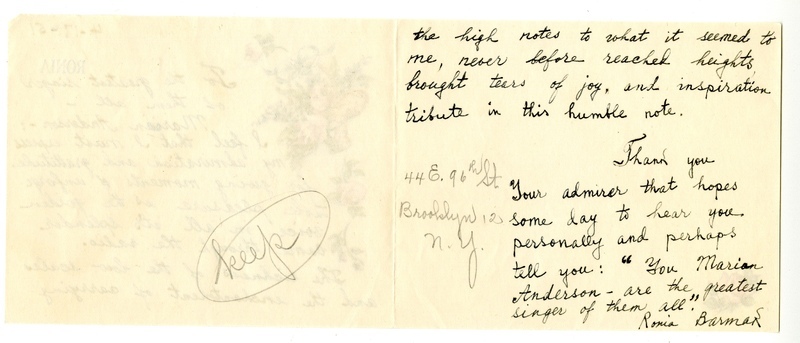Letter, Ronia Barmas to the greatest singer, April 17, 1951
Item
-
Title
-
Letter, Ronia Barmas to the greatest singer, April 17, 1951
-
Description
-
This letter was sent by Ronia Barnas presumably of Brooklyn, New York to Marian Anderson (February 27, 1897-April 8, 1993) on April 17th, 1951. The letter was written to complement Anderson on the remarkable beauty of her voice that reaches “never before reached heights” (p. 2). Signing the letter off as Anderson’s “admirer,” Barnas expresses her desire to hear her in person and say: “‘You Marian Anderson - are the greatest singer of them all.’”
-
Ronia’s letter is written in black pen ink, but written in pencil on the second page of the letter is an address– “44 E. 96th St. Brooklyn N.Y.”, as well as the word “keep.” This address is a multi-family home with 2 stories and 4 units (NYC Housing Preservation & Development, n.d.). Brooklyn telephone directories, the NYC Department of Records and Information Services, and Ancestry databases did not provide any additional information on Ronia.
Marian Anderson was born and raised in South Philadelphia to John and Anna Anderson, and had two younger sisters (Penn Libraries, n.d.). She would grow up to reach international fame as a contralto classical singer, and symbol of success and resilience (Penn Libraries, n.d.). Her singing career began in her family’s church chorus, and she sang and studied music and performance at William Penn High School and South Philadelphia High School for Girls (Penn Libraries, n.d.). Her church, local organizations, and the greater Black community helped to financially support and advance her early educational journey (Penn Libraries, n.d.). These opportunities and connections propelled her to local and regional fame; having first performed at the Philadelphia Academy of Music in 1918 and with the New York Philharmonic in 1924 (Penn Libraries, n.d.). She studied the arts internationally, making her first trip to Europe in 1928 (Penn Libraries, n.d.). At first funded by foundations and scholarships who saw immense talent in her, Anderson would continue to tour and travel internationally through her career (Marian Anderson Museum, n.d.).
Anderson is appreciated for paving the way for future Black performers, as she was the first Black female to perform at Carnegie Hall in 1928, the first Black singer to perform at the Metropolitan Opera in 1955, and the first Black singer to perform at a Presidential Inauguration in 1957 (Marian Anderson Museum, n.d.). She experienced racism in the United States more than other countries, and gently protested this in ways such as insisting auditorium seating be integrated, and “refus[ing] to sing where the audience was segregated” (National Marian Anderson Museum, n.d.). In 1936, Anderson performed at the White House in Washington, D.C. In 1939, she was to perform again in D.C.– her manager Sol Hurok suggested that she perform at Constitution Hall, the capital’s largest concert hall seating up to 3,702 people (Daughters of the American Revolution, n.d.). It is operated by the Daughters of the American Revolution, and they denied her the opportunity to perform due to the color of her skin (Penn Libraries, n.d.; DAR Public Relations, n.d.). Instead, she performed on Easter for over 75,000 people (plus radio listeners) on the steps of the Lincoln Memorial (National Marian Anderson Museum, n.d.).
Anderson received a plethora of awards, appointments, and over fifty honorary degrees including: an honorary membership in Alpha Kappa Alpha; honorary degrees from Howard University, Temple University, Smith College, and more; NAACP Spingarn Medal in 1939; the Philadelphia Award established by Edward Bok of which was particularly meaningful to her in 1941; appointment to the National Council on the Arts in 1966; the United Nations Peace Prize in 1972; Congressional Medal by President Carter in 1978; as well as the Grammy Lifetime Achievement Award in 1991 (Penn Libraries, n.d.; Anderson 1955, pp. 273-275; Marian Anderson Museum, n.d.).
Ronia’s letter is written in black pen ink, but written in pencil on the second page of the letter is an address– “44 E. 96th St. Brooklyn N.Y.”, as well as the word “keep.” This address is a multi-family home with 2 stories and 4 units (NYC Housing Preservation & Development, n.d.). Brooklyn telephone directories, the NYC Department of Records and Information Services, and Ancestry databases did not provide any additional information on Ronia.
Marian Anderson was born and raised in South Philadelphia to John and Anna Anderson, and had two younger sisters (Penn Libraries, n.d.). She would grow up to reach international fame as a contralto classical singer, and symbol of success and resilience (Penn Libraries, n.d.). Her singing career began in her family’s church chorus, and she sang and studied music and performance at William Penn High School and South Philadelphia High School for Girls (Penn Libraries, n.d.). Her church, local organizations, and the greater Black community helped to financially support and advance her early educational journey (Penn Libraries, n.d.). These opportunities and connections propelled her to local and regional fame; having first performed at the Philadelphia Academy of Music in 1918 and with the New York Philharmonic in 1924 (Penn Libraries, n.d.). She studied the arts internationally, making her first trip to Europe in 1928 (Penn Libraries, n.d.). At first funded by foundations and scholarships who saw immense talent in her, Anderson would continue to tour and travel internationally through her career (Marian Anderson Museum, n.d.).
Anderson is appreciated for paving the way for future Black performers, as she was the first Black female to perform at Carnegie Hall in 1928, the first Black singer to perform at the Metropolitan Opera in 1955, and the first Black singer to perform at a Presidential Inauguration in 1957 (Marian Anderson Museum, n.d.). She experienced racism in the United States more than other countries, and gently protested this in ways such as insisting auditorium seating be integrated, and “refus[ing] to sing where the audience was segregated” (National Marian Anderson Museum, n.d.). In 1936, Anderson performed at the White House in Washington, D.C. In 1939, she was to perform again in D.C.– her manager Sol Hurok suggested that she perform at Constitution Hall, the capital’s largest concert hall seating up to 3,702 people (Daughters of the American Revolution, n.d.). It is operated by the Daughters of the American Revolution, and they denied her the opportunity to perform due to the color of her skin (Penn Libraries, n.d.; DAR Public Relations, n.d.). Instead, she performed on Easter for over 75,000 people (plus radio listeners) on the steps of the Lincoln Memorial (National Marian Anderson Museum, n.d.).
Anderson received a plethora of awards, appointments, and over fifty honorary degrees including: an honorary membership in Alpha Kappa Alpha; honorary degrees from Howard University, Temple University, Smith College, and more; NAACP Spingarn Medal in 1939; the Philadelphia Award established by Edward Bok of which was particularly meaningful to her in 1941; appointment to the National Council on the Arts in 1966; the United Nations Peace Prize in 1972; Congressional Medal by President Carter in 1978; as well as the Grammy Lifetime Achievement Award in 1991 (Penn Libraries, n.d.; Anderson 1955, pp. 273-275; Marian Anderson Museum, n.d.).
More information is available in the letter's image annotations.
-
Map of Ronia's Brooklyn address
-
Penn Libraries Digital Collection on Marian Anderson
-
Rights
-
Copyright restrictions may exist. For most library holdings, the Trustees of the University of Pennsylvania do not hold copyright. It is the responsibility of the requester to seek permission from the holder of the copyright to reproduce material from the Kislak Center for Special Collections, Rare Books and Manuscripts.
-
Date
-
April 17,1951
-
Format
-
Text
-
Language
-
eng
-
Contributor
-
University of Pennsylvania: Kislak Center for Special Collections, Rare Books and Manuscripts
-
Extent
-
2 pages
-
Identifier
-
Ms. Coll. 200 Box 126
-
transcription
-
4-17-51
RONIA
To the greatest singer
of them all –
Marian Anderson – :
I feel that I must express
my admiration and grattitude
for giving moments of unforge-
table pleasure as the golden
voice in all it's splendor
came through the radio.
The richness of the low scales
and the enchantment of carrying
-
Subject
-
Anderson, Marian, 1897-1993.
-
Contraltos– United States– Biography.
-
Fan mail--United States.




